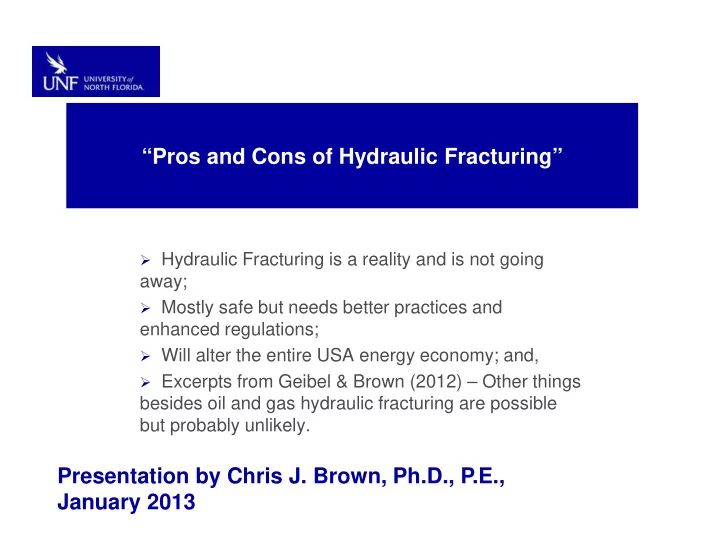

“Pros and Cons of Hydraulic Fracturing” � Hydraulic Fracturing is a reality and is not going away; � Mostly safe but needs better practices and enhanced regulations; � Will alter the entire USA energy economy; and, � Excerpts from Geibel & Brown (2012) – Other things besides oil and gas hydraulic fracturing are possible but probably unlikely. Presentation by Chris J. Brown, Ph.D., P.E., January 2013
Presentation Outline � Introduction – What is hydraulic fracturing ?; � At what water pressures do we see the onset of fracturing ?; � Where are prospective areas for H. fracturing ? � What is driving H. fracturing ? � Pros and Cons; � What about in Florida ? � FAS Hydrogeological Setting; � What is issue with Everglades ASR System?; � Questions.
What is hydraulic fracturing ? Unconfined Aquifer Confining Unit Confined Zone
What is hydraulic fracturing ? Source: Propublica
Typical Makeup of Fracturing Fluids Methanol; Isopropanol; Ethylene Glycol; Benzene; Lead; Diesel Fuel; Starch; Guar Gum; Source: API, Congressional Reports
Typical Well Site Source: NRDC
At what pressures do we expect onset of fracturing ? � 1930s and 1940s – P > 1 psi/ft of overburden depth; � Bouwer (1978) – P > 67% overburden pressure; � Driscoll (1986) – P > 0.50 psi/ft of overburden depth for coastal plain sediments/soft rock; � Driscoll (1986) – P > 1.2 psi/ft of overburden depth for crystalline rock; � Sterret (2007) – P > 1.0 psi/ft of overburden plus 1,500 psi – Intentional Fracture ; � Ehlig-Economides & Economides (2010) – P > 0.82 psi/ft of overburden depth;
Location of Shale Gas/Oil Resources in USA Source: EPA
EIA 2013 Annual Energy Outlook So what is driving the boom in hydraulic fracturing ? USA Data Source: EIA
EIA 2013 Annual Energy Outlook Source: EIA
EIA 2013 Annual Energy Outlook Source: EIA
EIA 2013 Annual Energy Outlook Source: World Energy Outlook 2012
What are the “Pros” ? � Reduce energy dependence on Middle East; � New development supported 600,000 jobs in 2011; � Cheap natural gas = more manufacturing in USA; � Future exporter of energy ?? � Reduced generation of greenhouse gas due to replacement of coal with natural gas. � In 2000 16% of power generated with nat gas; � In 2030, 30% use predicted.
What are the “Cons” ? � Huge water demand; � Huge amount of wastewater generated; � Poor or limited regulation – Energy Policy Act of 2005 excludes most hydraulic fracturing from being regulated under SDWA, UIC program; � Potential for cross-contamination of drinking water aquifers with fracturing chemicals or more likely, methane; � See cases in Wyoming, Colorado, and PA; � Induced seismic activity from deep injection wells; and, � Extend our reliance on fossil fuels.
Geology of Shale Gas Areas Source: Osborn et al. 2011
Hydrogeologic Setting Source: USGS
What is the concern with ASR operations ? � Proposed Everglades ASR Program includes up to 333 wells in southern Florida;
What is the concern with ASR operations ? � Pore pressures within the FAS would get elevated;
Predicted State of Stress During Injection SAS 32 to σ σ 1 210 feet σ σ HG 396 to 735 feet σ 3 σ σ σ σ 3 σ σ σ Element At top of FAS FAS
Methodology � Use 3 primary evaluation methods and 2 “check” methods; � Primary Methods included: � Shear Failure; � Tensile Failure; and, � Microfracture Development. � Check Methods included: � Goodman (1980) – Modified Mohr-Coulomb Failure Envelope; and, � Bouwer (1978) – P > 50 to 67% of Overburden pressure.
Summary of Laboratory Rock Testing Data � Both UU and Triaxial tests with confining pressure were completed; � Also 1 sample was subjected to splitting tensile strength test; � UCS ranged from 330 to 1,980 psi; � UCS arithmetic mean was 998 psi; � Phi Angle arithmetic mean was 28.9 degrees; and, � Cohesion arithmetic mean was 332 psi.
Results � Using the 3 methods presented earlier: � Shear Failure – Unlikely given the well head pressures would have to exceed rock shear strength of about 500 psi; � Tensile Failure – Onset estimated at well head pressures of 139 to 237 psi or total head of 343 to 559 feet; and, � Microfracture Development – Onset estimated at well head pressure of 95 to 166 psi or total head of 233 to 395 feet.
Results � Using the 3 methods and fracture gradients: � Shear Failure – Equates to about 0.73 psi/ft; � Tensile Failure – Equates to about 0.69 psi/ft; and, � Microfracture Development – 0.61 psi/ft. Results Seem Reasonable When Compared To Literature Values…..
Questions ? � Thank you for the opportunity to provide this presentation. � Further information can be found at Geibel, N.M. & Brown, C.J. (2012) Hydraulic Fracturing of the Floridan Aquifer from Aquifer Storage and Recovery Operations , Environmental and Engineering Geoscience , 18(2): 175-189. Christopher.j.brown@unf.edu
Recommend
More recommend